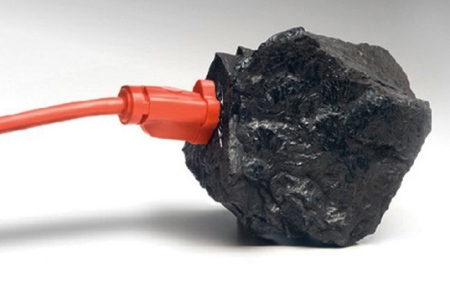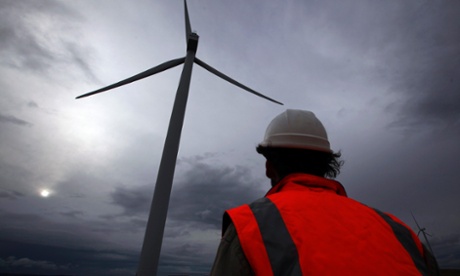I recently
wrote about—and debunked—the renewables “disinformation campaign” that spreads misinformed and falsely negative stories about the growth of renewable energy. A
special focus of such disinformation has been reportage on Germany’s efficiency-and-renewables
revolution. The impressive
success so far of the German
Energiewende (energy turnaround) is an important existence proof for the world, because Germany is cloudy, high-latitude, heavily industrialized, highly competitive (it rivals America’s merchandise exports with one-fourth its population), and the world’s fourth-biggest economy.
Perhaps because German success would therefore belie the supposed necessity of fossil-fuel and nuclear energy, some media regularly report the
Energiewende’s failure or supposed impossibility. As I
highlighted, Germany’s renewables revolution is in fact highly successful and strong as ever, but that hasn’t stopped three myths from gaining traction in the media: 1) Germany’s supposed turn back to coal, 2) how renewables undermine grid reliability, and 3) how renewables subsidies are cratering the German economy. None of those are true, and here’s why.
Myth #1: Germany’s Turn Back To Coal
An efficient new German coal plant begun in 2006, with fast ramp rates to complement variable renewables, was widely but wrongly
heralded on its commissioning in 2012 (Europe’s only new coal plant that year) as signaling Germany’s post-Fukushima turn back to coal—not mentioning that it replaced a larger amount of dirtier and far less efficient coal capacity that was shut down. Moreover, replacing old 35-to-38-percent-efficient coal units with modern
46-percent-efficient ones, like some of the
5.3 GW likely to come online this year, would save a fifth of their coal even if net capacity didn’t change. And though capacity may fluctuate for a few years, the German Energy Agency
expects 11.3 GW of coal capacity to be added
and 18.5 GW closed by 2020—a net decrease of at least 7.2 GW.
In fact, as explained
here and
here, Germany has begun no new coal plants since Fukushima, coal-fired
generation will
decline even more than capacity, lignite has
no future, and any of the coal plants planned long ago that are completed—
offsetting retiring units—are
likely to lose money, just as existing ones do
now. Another instance in
Hamburg reinforces these points. Yet
claims continue to propagate that “Germany alone is building 25 coal-fired plants” (
20 of 29 originally proposed have already been stopped, 5–6 more shelved) and that “it has now become very, very cheap to burn coal and as a result, there’s a new coal boom in Europe” (
nearly all in Britain and Spain), while renewables are “helping to continue the economic collapse of Germany” (Europe’s strongest economy).
German coal-fired generation did rise modestly in 2011–12, substituting for pricier natural gas, about half of which in Europe is price-linked to oil. Very low prices in Europe’s oversupplied carbon emissions market further
reduced the price of burning coal. Similarly in the first seven months of 2013
compared with a year earlier, three-fourths of the rise in coal-fired generation was due to substitution for gas, the rest to lighter winds—though electricity demand probably declined too.

image via BSW Solar
This temporary coal-burning uptick is often used to claim that German CO2 emissions are rising, even though emissions have trended down since 1990. In
fact, despite economic growth, German renewables helped make CO2 emissions fall in 2011, hold steady for power plants and industry in 2012, and probably fall in total in 2012 after adjustment for more oil-fired heating in the exceptionally cold winter. The reason is simple: Germany’s renewable growth has more than offset nuclear shutdowns while efficiency has flattened or decreased electricity demand. It’s not even
possible for German power plants to
emit more CO2 because of their national emissions cap under EU law.
Flatly contradicting the official
data, anti-renewables reports often claim that Germany is going back to coal because renewables didn’t work and are proving unaffordable. Actually, they work just fine, supplying 23 percent of German electricity in 2012 (more than any other source except lignite) and driving dramatically
lower wholesale power prices that are
attracting energy-intensive industry, making German industrial power highly
competitive, and enabling record 2012 power exports that
rose another 62 percent in the first half of 2013. (Germany is the only country that consistently
exports power to France; its industrial power is
cheaper than the EU average, and the gap is widening.) American media,
rerunning many of these false stories, are awkwardly having to
shift their tune from “renewables are too costly to compete” to “renewables are walloping our favorite old technologies.” Indeed, German photovoltaics
today have achieved the price that the European Union in 2011 projected for 2050.
It’s hardly
a surprise for the threatened coal industry to
claim “many large industrial corporations are migrating out of [Germany].” But for
The Economist to
make a similar
claim, also without a single example, is unusual: Germany’s top energy economist
sees no sign of industrial flight, nor has a
request for examples elicited any. Yet the canard persists. Perhaps such confusion is due to U.S. expansion of gas-intensive chemical giants like
BASF, which naturally pivot toward
fourfold-cheaper U.S. natural gas because it’s both a fuel and a feedstock; BASF in Germany also makes
70 percent of its electricity internally from natural gas. But as Craig Morris of
Renewables International notes, chemical firms’ U.S. expansions are driven by U.S. gas prices, not German electricity prices. Giant German firms enjoy Germany’s low and falling wholesale electricity prices, getting the benefit of renewables’ near-zero operating cost but exempted from paying for them, as I’ll describe below.
The truth about German industrial electricity prices (such as the wholesale
spot and
futures market quotations) is easily determined from official statistics, which are far more transparent and thorough than America’s. Even as GE’s Chairman griped that a German steel mill pays four times the typical U.S. industrial power price (perhaps reflecting a confusion between U.S. and Euro cents), the average German wholesale price for June 2013—essentially the price such big industries pay—
fell to a record low of 2.8 Euro cents or 3.7 U.S. cents per kWh, well below his 5-cent U.S. benchmark. To be sure, the average retail kWh bought by the
entire German industrial sector, much of it small and midsized,
cost 8.6 U.S. cents for energy plus 8.0 for taxes,
vs. 6.5 cents in the largely tax-free U.S., so smaller firms’ total tariff, typical in Europe, is about
twice the U.S. level. But renewables don’t account for that gap; German industry is thriving anyhow because it’s efficient; and U.S. electricity prices rose 4.8 during 2007–12 and 44 percent during 1995–2012—faster than the
German increases of 3.7 and 16 percent.
Thus Germany is building the renewable foundation for
declining long-term electricity prices. Sure enough, German
wholesale power prices have
fallen about 30 percent in the past two years to near eight-year lows, putting utilities that underinvested in renewables under
severe profit pressure. This success in using modern renewables to reduce and stabilize electric generating costs is sometimes misdescribed as a failure because it creates losers—those who bet against it—as well as the winners who bet on its success.
Myth #2: Renewables Undermine Grid Reliability
Another common misreportage theme is that renewables are degrading the reliability of Germany’s power supply, driving industry abroad. The president of Germany’s network agency has
confirmed this is not true. Hearsay anecdotes alleging renewable-caused power glitches are often traceable to
Der Spiegel, a frequent source of anti-renewable
stories, but evaporate on scrutiny. Charles Mann in
The Atlantic cites five references to bolster such claims, but his sources (cited in my
response) don’t support his case. One, from a
Koch-allied anti-renewable front group (whose political arm, the American Energy Alliance, lobbies for fossil fuels and against renewables), claims renewables are “causing havoc” in the German grid, the other four sources don’t, and
none of the five offers any evidence this is happening, because it’s not—as I confirmed with German experts in May 2013, when I was co-keynoting the Chancellor’s electromobility conference in Berlin.
But
Der Spiegel is not alone in such misreporting.
Die Zeit and others have described local electricity problems caused by a failed coal plant and by restricted Russian gas deliveries as if they proved the unreliability of renewables, which had nothing to do with them.
Focus likewise
blamed a Munich power outage on renewables, then reported the actual, unrelated cause (a transformer blew up) without a correction.
To be sure, Germany’s grid, built for central stations, was scarcely expanded as renewable generation soared from 3 percent to 23 percent in 20 years. Grid modernization and debottlenecking are therefore needed and are vigorously underway— though the network agency recently
slashed plans for new transmission corridors by nearly half because many projects proved unnecessary, and grid investments apparently
needn’t rise. But fear of what might happen if those future grid improvements weren’t made doesn’t justify the lie that blackouts and brownouts are rife today.
In fact, German power, like 22-percent-solar-and-windpowered Spanish and 30-percent-windpowered Danish power (both for all of 2012), remains far more
reliable than U.S. power and is getting even more reliable. Germany ranks #1 in European grid reliability, Denmark just behind, both about tenfold better than the U.S. Likewise, as Spain’s solar and windpower soared in the past few years, Spain’s reliability index
rose too. Across Europe, renewable expansion
correlates with
more reliable power. Now a German company has even
assembled a 570-MW virtual power plant of dispatchable renewables, available nationwide to firm (guarantee steady output from) the varying wind and solar output. Dispatching variable resources is more complex, but the grid’s skilled operators do it well.
The next round of misreporting will doubtless emerge from a new grid-operator
survey showing that 7 percent of German firms surveyed (or 25 percent of those that could in principle move production abroad) say they are considering doing so “because of a (possible) worsening of grid reliability.” However, no trend can be inferred because this question was never previously asked; no comparison is possible because it wasn’t asked in other countries; and, of course, reduced reliability is a future hypothetical, not a present reality. The European standard metric, to be sure, doesn’t include outages shorter than three minutes, so vague claims that even briefer outages are rising in Germany can’t be tested from the data — only cast in doubt by lack of specific anecdotal examples
Myth #3: Renewables Subsidies Are Cratering The Germany Economy
Perhaps most confusing is Germany’s lively debate about the surcharge that utility customers pay to finance the feed-in tariff (“FIT”)—a fixed 20-year power purchase contract offered to anyone installing new renewable generators, whether solar, wind, biomass-fueled, or other kinds. (Since 2012, you can instead choose market-based payments, as half of renewable producers and four-fifths of windpower operators
do, and since autumn 2012, new solar systems over 10 megawatts are
no longer eligible for FITs). The FIT declines as renewables’ growth drives down their prices; rooftop solar’s FIT is falling 1.8 percent every month. But partly because prices are falling, solar sales are far outpacing forecasts, raising the surcharge.
USA Today columnist Sumi Somaskanda recently
wrote: “German consumers are waking up to the costs of going green: As of Jan. 1, they are paying 11 percent more for electricity than they did last year thanks to government plans to replace nuclear plants with wind and solar power that requires significant and constant public money to be made cost effective.” But as I
wrote in April, the truth is quite different.
Germany’s renewables surcharge is artificially
inflated by hefty and rising industry
exemptions that place greater burdens on households—a policy now under legal
investigation by the EU as a potential illegal subsidy— but it is not public money, is not a subsidy (Germany hasn’t subsidized photovoltaics since 2004), and is a
minute drop in the bucket of German households’ energy costs. It works just like the way many American households pay prices set by state regulators for approved power plants, only it’s far more transparent — and in Germany you have the option of earning back your payments, and far more, by investing as little as
$600 in renewable energy yourself.
Citizens,
cooperatives, and communities own more than half of German renewable capacity,
vs. two percent in the U.S.
In 2013, the FIT surcharge raised households’ retail price of electricity 7 percent but renewables
loweredbig industries’ wholesale price 18 percent. As long-term contracts expire, the past few years’ sharply lower wholesale prices could finally reach retail customers and start sending households’ total electricity prices back down. The latest
analysis suggests that this may even occur in 2014, sooner than expected.
Critics of renewables try to inflate the FIT surcharge into a big issue because there are no big issues: the
consensus supporting Germany’s renewables policy is
broad,
deep, and durable. Nonetheless, shrill misrepresentations of Germany’s supposedly exorbitant renewable surcharge abound. For example, Bjørn Lomborg, the neoliberal Danish author of the
controversial book
The Skeptical Environmentalist, applies to Germany the same error he propagates about Danish electricity prices, which he claims are among Europe’s highest (supposedly due to windpower)—without mentioning they’re among the lowest prices pretax but are heavily taxed. (German household electricity prices,
graphed here for 1998–2013, are roughly half taxes.)
Similarly, Lomborg
trumpets “Electricity [real] prices for German households have increased 61 percent since 2000—renewables blamed” even though such blame is patently false, as
Craig Morris and
I both explain. Lomborg even implies the renewable electricity surcharge makes up to 800,000 Germans unable to pay their electric bills—both a misattribution and an exaggerated number (the
actual figure, though uncertain, seems well below its equivalent in other countries). This “disingenuous” debate about the renewable surcharge’s alleged price impact on the poor, as Craig Morris trenchantly
puts it, is about how “promoters of corporate control of energy have suddenly discovered their compassion for people who have their power cut off by corporations.” Lomborg even claims the renewable surcharge is “why more people are stealing wood from German forests”—but a far more logical explanation is the roughly 119-percent rise in the real price of heating oil since 2000.
Conclusion
Germany’s
Energiewende is a bold, challenging, and complex experiment. Its inevitable imperfections need, and get, recognition and correction. On the whole, it has been highly successful so far and is on track for its seemingly ambitious goals—renewable electricity rising to 35 percent of consumption by 2020 and 80 percent by 2050, primary consumption falling respectively to 20 and 50 percent below 2008 levels, and CO2 emissions falling to 30 and 80 percent below 1990 levels. In fact, Germany could even surprise the world by going even further and faster. Success is not guaranteed, but impressive achievements so far suggest it would be unwise to bet against German skill and determination. Getting the facts right is the safest way to bet wisely.












